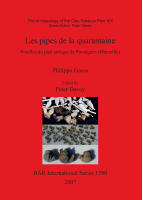Description
BOOK DESCRIPTIONThe collection of almost 1,000 clay pipes from the quarantine port of Pomègues provides a unique insight into pipe production and use throughout the Mediterranean and further afield. The author's exhaustive study makes a significant contribution to knowledge both of pipe production and circulation in a number of different ways. Although these have already been recognised and published from a range of sites throughout the Mediterranean basin, the Pomègues collection, arriving off Marseilles on ships from many ports of origin, is by far the most extensive and varied yet collected. This study establishes a logical nomenclature for the formal and technical variables that can be observed on these pipes. The Pomègues assemblage demonstrates clearly that a wide range of stylistic and constructional forms, many previously though to be late, coexisted over a wide geographical area. All existing dating typologies for Ottoman-style pipes will now have to be revised. Using existing published groups from specific sites and areas the author has attempted to identify the origins of the pipes within the Empire - whether from north Africa, the Near East, Asia Minor or Greece. Quite apart from the Ottoman-style pipes, the author provides an interesting study of the extensive Dutch element in the Pomègues collection. The pipes derive from a large number of makers and a number of probable centres and include a range of qualities, including possible copies. An attempt to combine stem-bore analysis, bowl form and maker information in a single dating statement for each pipe provides an original contribution to the study of Dutch pipes from this kind of context. The English pipes are fewer in number and more difficult to source with few distinctive regional forms or makers'marks. This study describes and identifies for the first time a major pipe production centre in Venice, producing thrown pipes in a specific technology, contrasting with the well-known moulded types from Chioggia. Finally, the author has defined, albeit tentatively, a range of 18th-century products from France and provides some indication of how such pipes can be identified in the future. This is important as very little research has been carried out on the products of an industry which, from the documentary sources, was a significant one.











